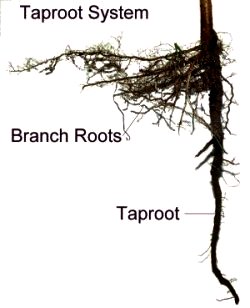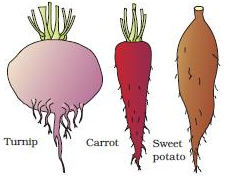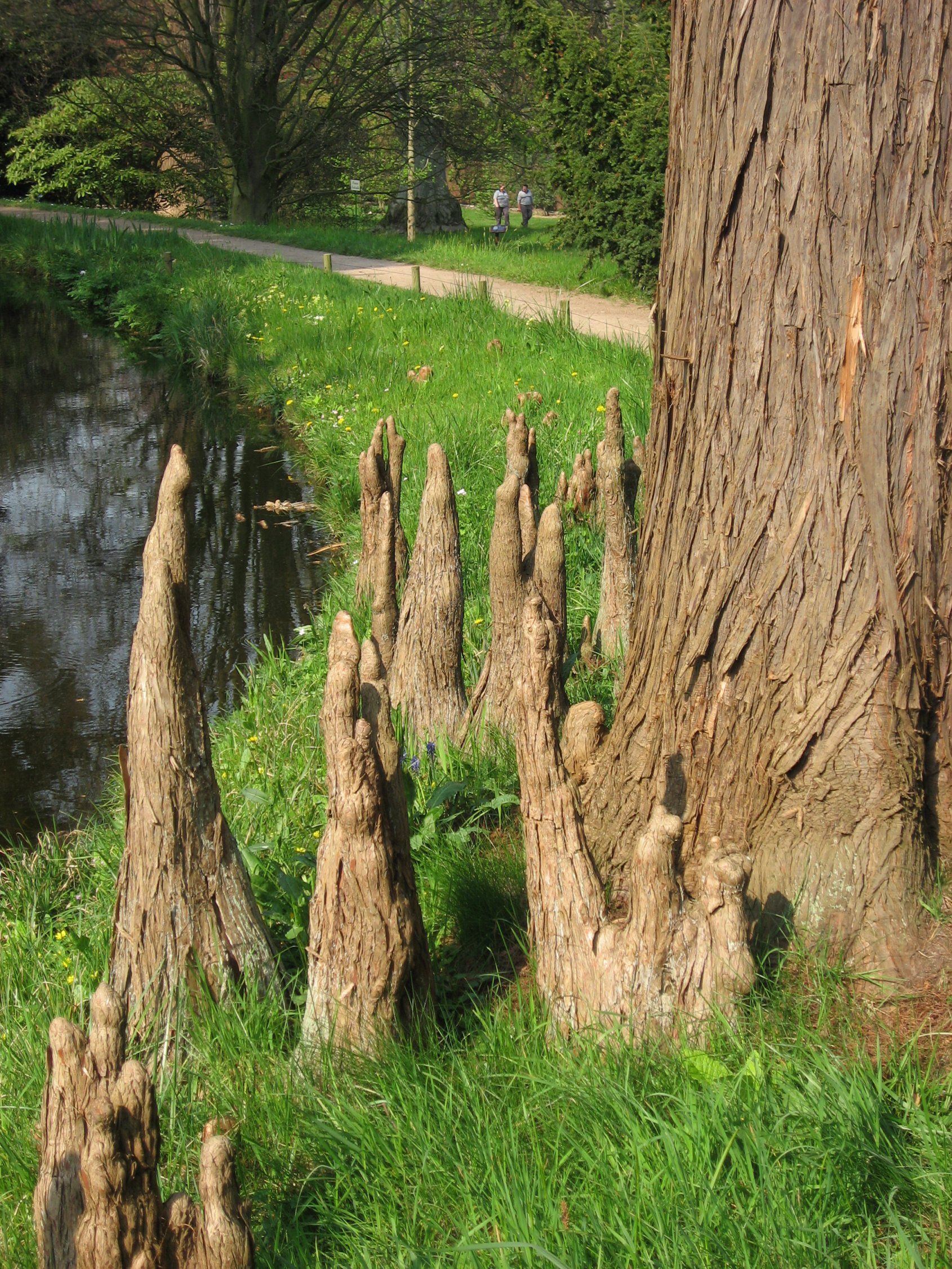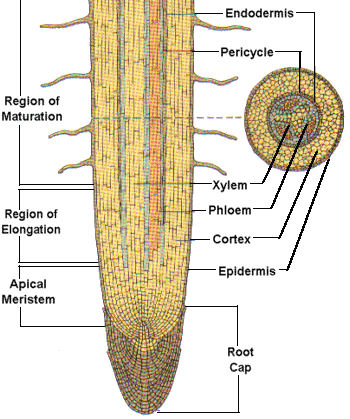Root
Table of Content |
 The root is usually an underground part of the plant which helps in fixation and absorption of water.
The root is usually an underground part of the plant which helps in fixation and absorption of water.
The root with its branches is known as the root system.
Characteristics of the Root
(i) The root is the descending portion of the plant axis and is positively geotropic.
(ii) It is non-green or brown in colour.
(iii) The root is not differentiated into nodes and internodes.
 (iv) As a rule the root does not bear leaves and true buds.
(iv) As a rule the root does not bear leaves and true buds.
(v) Usually the root tip is protected by a root cap.
(vi) The root bears unicellular root hairs.
(vii) Lateral roots arise from the root which are endogenous in origin (arises from pericycle).
Parts of the Root
From the tip of the root upwards, the following parts can be traced in root.
(i) Region of root cap : The tip of the root is called calyptra or root cap. It is for protection of root tip against any injury. It is formed from meristem called calyptrogen. Pandanus is the only plant with multiple root caps. In the aquatic plants like Pistia, Lemma and Eicchornia instead of root caps, they have root pockets for buoyancy. The root caps are absent in parasites and mycorrhizal roots.
(ii) Region of cell elongation : The region of cell division lies partly within and partly beyond the root cap. This is the meristematic region of the root which produces new cells by cell division.
(iii) Region of Root Hairs: This region is present above the region of elongation. In this region the epidermal cells produce many tubular, unicellular outgrowths called root hairs. This is also called Piliferous region. Water absorption mostly takes place through this region. The root hairs are absent in many aquatic plants.
(iv) Region of Maturation : Above the root hair zone, mature region is present. This region consists of permanent cells. Lateral roots are produced endogenously from the mature region. Conduction of water and mineral salts takes place through this region.
Types of Root System
The root system is generally of two types:
(i) Tap root system
(ii) Adventitious root system
Tap Root System
-
 The tap root system develops from radicle of the germinating seed.
The tap root system develops from radicle of the germinating seed. -
The radicle develops into a primary root which grows vertically downwards and become the tap root.
-
The tap root is the true root that produces many lateral roots endogenously which grow obliquely.
-
The tap root system is present in dicotyledonous plants.
Adventitious Root System
-
The root system that develops from any part of the plant body other than the radicle is called the adventitious root system.
-
In grasses, fibrous root system is present.
-
In this case the primary root formed from the radicle disappear soon.
-
Then many slender roots develop from the base of the stem as cluster of fibres, hence called the fibrous root system.
-
Shrub like monocots needs additional support because of the adventitious root. e.g., Stilt root in sugarcane.
Modification of Roots
Sometimes the root performs other functions other than fixation, absorption and conduction so get modified structurally. Both tap roots and adventitious roots may undergo such modifications. There are many types of root modifications.
Modification of Tap Roots
 (i) Storage roots : In some plants, the primary tap roots are modified for storing reserve food materials. The secondary roots remain thin and they are absorptive in function. The storage roots are usually swollen and assume various forms :
(i) Storage roots : In some plants, the primary tap roots are modified for storing reserve food materials. The secondary roots remain thin and they are absorptive in function. The storage roots are usually swollen and assume various forms :
(a) Conical : The swollen root is broad at the base and tapers gradually towards the apex giving a shape of cone, e.g., Carrot.
(b) Fusiform : The root is swollen in the middle and narrow towards both its base and apex giving a shape of spindle, e.g., Radish (Raphanus sativus). Half or less than half portion towards the base of fusiform root is formed by hypocotyl.
 (c) Napiform : The root is nearly globular or spherical in shape. The basal portion of root is much swollen which suddenly tapers towards the apex giving a top-shaped appearance, e.g., Turnip (Brassica napus, vern, Shalgam) and Beet (Beta vulgaris, vern. Chukandar).
(c) Napiform : The root is nearly globular or spherical in shape. The basal portion of root is much swollen which suddenly tapers towards the apex giving a top-shaped appearance, e.g., Turnip (Brassica napus, vern, Shalgam) and Beet (Beta vulgaris, vern. Chukandar).
(d) Tuberous : The storage root having no definite shape is called tuberous, .e.g., Mirabilis jalapa (4 O’clock plant), Trichosanthes (vern. Parwal), Echinocystis lobata (The tuberous root is lobed and weighs as much as 22 kg.).
(ii) Branched roots : They are following types :
(a) Nodular roots : The primary tap roots and its branches of leguminous plants, i.e., plants belonging to sub-family papilionatae of the family leguminosae (e.g., Pea, Gram, Ground nut, Beans etc.), bear nodule like swellings, called root nodules.

|
(b) Pneumatophores or Respiratory roots :
-
Roots also breathe and as such they also require air for gaseous exchange.

-
Normally, the soil has a large number of small air spaces between the soil particles.
-
This air is utilized by the plants for their respiration. But the roots of some plants growing in saline marshes (mangrove plants) suffer from the lack of oxygen.
-
This is due to the water logged condition of the soil.
-
To cope with this situation some root branches grow vertically upwards. They become aerial and negatively geotrophic.
-
These roots bear many minute pores called pneumathodes towards their upper ends.
-
Gaseous exchange takes place through pneumathodes.
-
Such aerial, porous negatively geotrophic roots which help in gaseous exchange are called breathing or respiratory roots, breathing roots or pneumatophores roots or pneumatophores e.g., Sonneratia, Heritiera, Rhizophora, Avicennia and Ceriops etc. and are found in sundarbans of West Bengal.
Modification of Adventitious Roots
(i) For physiological or Vital functions
(a) Storage roots : The roots where adventitious roots become swollen to store food. They are following types :
-
Tuberous roots : These adventitious roots are swollen without any definite shape e.g., Ipomoea batata or (sweet potato).
-
Fasciculated roots : These are tuberous roots arising in cluster from the base of the stem. e.g., Dahlia, Ruellia (Menow weed), Asparagus (Asparagus fern) etc.
-
Nodulose roots : These roots become swollen at their tips due to accumulation of food e.g., Maranta sp. (Arrowroot), Curcuma amanda (Mango – ginger).
-
Moniliform or Beaded roots : These adventitious roots are swollen at frequent intervals. This gives the root a beaded appearance. e.g., Portulaca (Rose moss) Momordica (Bitter gourd) Cyperus (Guinea rush).
-
Palmate tuberous roots : In Orchis there is a pair of succulent tuberous root, one of which perishes every year while another new one is formed by its side. Such orchid roots may sometimes be of palmate shape, therefore, called palmate roots.
-
Annulated roots : The roots of a medicinal plant, Ipecac (Cephaelis ipecacuanha) yields emetine that looks like discs placed one above another, therefore, called annulated.
(b) Epiphytic roots : These roots are also called ‘hygroscopic roots’. These roots develop in some orchids which grow as epiphytes upon the trunks or branches of trees. They hang freely in the air and absorb moisture with the help of special sponge like tissue called velamen. Velamen is modification of epidermis. e.g., Venda, Dendrobium etc.
(c) Parasitic or Haustorial roots : Plants which depend on plant partially or totally for their food material are known as parasites. The roots of parasitic plants, which penetrate into the host tissues to absorb nourishment, are called haustorial roots. The haustorial roots of Cuscuta (Dodder, vern. Amarbel) penetrates the host upto phloem and xylem to absorb organic food, water and minerals. The haustorial roots of partial parasite – Viscum (Mistletoe) penetrate upto xylem of host to absorb water and minerals.
- Parasite which absorb their nutrients from the host stem are known as stem parasites while those which absorb their nutrients from the host root are know as root parasite.
(d) Saprophytic roots : They are also called mycorrhizal roots as here roots are associated with fungal hyphae either superficially (ectomycorrhizae) or internally (endomycorrhizae) for absorption of water and minerals. e.g., Monotropa and Sarcodes.
(e) Photosynthetic or Assimilatory roots : These are green, aerial, adventitious roots which prepare food materials by photosynthesis are called photosynthetic roots or assimilatory roots e.g., Taeniophyllum, Trapa and Tinospora. In some epiphytes like Taeniophyllum, the stem and leaves are absent. The entire plant is represented by thin green, ribbon like roots which contain velamen. These roots absorb moisture from the atmosphere and manufacture food materials by photosynthesis. Since the roots are green and perform photosynthetic activity, these roots are called photosynthetic roots or assimilatory roots.
(f) Reproductive roots : Some fleshy adventitious root develop buds which can grow in to new plants. These are called reproductive root. These roots serve as means of vegetative propagation. e.g., Sweet potato, Dahlia etc.
For Mechanical Function
(a) Stilt Roots:
-
 The aerial, adventitious obliquely growing roots that develop from the lower nodes of the stem to give additional support are called stilt roots.
The aerial, adventitious obliquely growing roots that develop from the lower nodes of the stem to give additional support are called stilt roots. -
This root bears several large overlapping root caps called multiple root caps. e.g., Sugarcane, Pandanus, Rhizophora, Sorghum and Maize. Pandanus (screw pine) is a common sea shore plant.
-
They also help in the absorption of water and minerals from the soil.
-
In monocots, these roots arise in whorls from a few basal nodes of stem.
(b) Prop Roots:
-
These adventitious aerial roots arise from horizontal aerial branches of the trees like Ficus bengalensis (Banyan).

-
Initially, they are hygroscopic in function, become red in moist condition and possess root-caps at their apices.
-
They grow vertically downward, penetrate the soil, become thick and assume the shapes of pillars.
-
They provide support to the spreading branches of tree.
-
Sometimes the main trunk dies and it is replaced by prop roots which assume the shapes of trunks.
-
In India, the biggest banyan tree having large number of prop roots is found at Indian Botanical Gardens, Kolkata and Kadiri (Andhra Pradesh).
(c) Buttress Roots:
-
The horizontal plank like aerial, adventitious roots that develop at the base of the stem to give additional support are called buttress roots or ballast roots, e.g., Terminalia and Salmalia.
-
In some huge and heavy trees, plank like roots develop at the base of the stem on the soil surface.
-
These roots give additional support and act like ballasts. Hence these roots are called ballast roots.
(d) Climbing Roots:
-
 The aerial adventitious roots that arise from the nodes or internodes of weak stemmed plants to climb up their support are called climbing roots, e.g., Pothos, Piper betel, Vanilla and Hedera.
The aerial adventitious roots that arise from the nodes or internodes of weak stemmed plants to climb up their support are called climbing roots, e.g., Pothos, Piper betel, Vanilla and Hedera. -
Many weak stemmed plants climb up their supports in order to expose their leaves efficiently to sunlight.
-
In Pothos and Hedera, climbing roots develop all over the stem.
-
In Vanilla, single tendril like root arise at each node. Hence they are called tendrillar roots.
-
In Piper betel, many short branched, adventitious roots arise at each node. These roots are called clinging roots.
(e) Floating Roots:
-
These roots develop from the nodes of floating aquatic plants like Jussiaea (=Ludwigia).
-
 They store air, become inflated and spongy, project above the level of water, make the plant light and function as floats.
They store air, become inflated and spongy, project above the level of water, make the plant light and function as floats.
(f) Contractile or Pull Roots:
-
Some roots of plants with underground stems contract or swell so that the aerial shoots are kept in a proper depth in the soil.
-
These roots are called contractile or pull roots, e.g., Canna, Crocus, Allium, Lilium, Freesia, etc.
(g) Root thorns : In aroids like Pothos and many palms (Acanthorhiza and Iriartea) the adventitious roots become hard and pointed hence called root thorns.


Question 1 : Water is absorbed by
(a) Root hairs
(b) Root cap
(c) Root
(d) Root apex
Question 2 : Black pepper is a
(a) Tree
(b) Climber
(c) Shrub
(d) Herb
Question 3 : Pneumatophores occur in plants of
(a) Sandy soil
(b) Saline marshy soil
(c) Marshy soil
(d) Water
Question 4 : Roots developing from plant parts other than radicle are
(a) Epiphyllous
(b) Epicaulous
(c) Adventitious
(d) Fibrous
Question 5 : Roots are feebly developed in
(a) Hydrophytes
(b) Mesophytes
(c) Xerophytes


|
Q.1 |
Q.2 |
Q.3 |
Q.4 |
Q.5 |
|
a |
b |
b |
c |
a |
Related Resources
-
Click here to refer the Useful Books of Biology for NEET (AIPMT)
-
Click here for study material on Anatomy of Flowering Plants
To read more, Buy study materials of Morphology of Flowering Plants comprising study notes, revision notes, video lectures, previous year solved questions etc. Also browse for more study materials on Biology here.
View courses by askIITians


Design classes One-on-One in your own way with Top IITians/Medical Professionals
Click Here Know More

Complete Self Study Package designed by Industry Leading Experts
Click Here Know More

Live 1-1 coding classes to unleash the Creator in your Child
Click Here Know More


